Optimizing Shading and Thermal Performances of Vertical Green Wall on Buildings in a Hot Arid Region
Abstract
:1. Introduction
2. Methodology
2.1. Premlinary Field Measurements
2.2. Building and Green Wall Models
2.3. Validation of the Simulation Model
3. Results and Discussion
3.1. Real Experiment Results
3.1.1. Exterior Surface Wall and Cavity Temperature
3.1.2. Interior Surface Wall and Room Temperature
3.1.3. Daylight Results
3.2. Simulation Results, Optimization Variables
3.2.1. Green Facade Foliage Scenarios
3.2.2. Optimal Cavity Depth
4. Conclusions
- Direct green wall with foliage coverage between 50% to 70%.
- Indirect green wall with foliage coverage of around 60%, and cavity depth no more than 0.6 m.
- Using a high foliage ratio should consider other performance indicators such as daylight and view.
- In hot climates with more direct sun, the cooling process during the nighttime required less foliage and a large cavity to allow heat exchange by convection and heat release to the ambient air.
Author Contributions
Funding
Institutional Review Board Statement
Acknowledgments
Conflicts of Interest
References
- Andric, I.; Kamal, A.; Al-Ghamdi, S.G. Efficiency of Green Roofs and Green Walls as Climate Change Mitigation Measures in Extremely Hot and Dry Climate: Case Study of Qatar. Energy Rep. 2020, 6, 2476–2489. [Google Scholar] [CrossRef]
- Yang, F.; Yuan, F.; Qian, F.; Zhuang, Z.; Yao, J. Summertime Thermal and Energy Performance of a Double-Skin Green Facade: A Case Study in Shanghai. Sustain. Cities Soc. 2018, 39, 43–51. [Google Scholar] [CrossRef]
- Yazdanseta, A. Designing Green Walls: An Early-Design Framework to Estimate the Cooling Impact of Indirect Green Walls on Buildings in Six Different Climates. Ph.D. Thesis, Harvard University, Cambridge, MA, USA, October 2017. [Google Scholar]
- Hoelscher, M.-T.; Nehls, T.; Jänicke, B.; Wessolek, G. Quantifying Cooling Effects of Facade Greening: Shading, Transpiration and Insulation. Energy Build. 2016, 114, 283–290. [Google Scholar] [CrossRef]
- Xing, Q.; Hao, X.; Lin, Y.; Tan, H.; Yang, K. Experimental Investigation on the Thermal Performance of a Vertical Greening System with Green Roof in Wet and Cold Climates during Winter. Energy Build. 2019, 183, 105–117. [Google Scholar] [CrossRef]
- Susorova, I.; Azimi, P.; Stephens, B. The Effects of Climbing Vegetation on the Local Microclimate, Thermal Performance, and Air Infiltration of Four Building Facade Orientations. Build. Environ. 2014, 76, 113–124. [Google Scholar] [CrossRef]
- Larsen, S.F.; Filippín, C.; Lesino, G. Thermal Simulation of a Double Skin Façade with Plants. Energy Procedia 2014, 57, 1763–1772. [Google Scholar] [CrossRef] [Green Version]
- Cuce, E. Thermal Regulation Impact of Green Walls: An Experimental and Numerical Investigation. Appl. Energy 2017, 194, 247–254. [Google Scholar] [CrossRef]
- Teotónio, I.; Silva, C.M.; Cruz, C.O. Economics of Green Roofs and Green Walls: A Literature Review. Sustain. Cities Soc. 2021, 69, 102781. [Google Scholar] [CrossRef]
- Addo-Bankas, O.; Zhao, Y.; Vymazal, J.; Yuan, Y.; Fu, J.; Wei, T. Green Walls: A Form of Constructed Wetland in Green Buildings. Ecol. Eng. 2021, 169, 106321. [Google Scholar] [CrossRef]
- Viecco, M.; Jorquera, H.; Sharma, A.; Bustamante, W.; Fernando, H.J.S.; Vera, S. Green Roofs and Green Walls Layouts for Improved Urban Air Quality by Mitigating Particulate Matter. Build. Environ. 2021, 204, 108120. [Google Scholar] [CrossRef]
- Kenai, M.-A.; Libessart, L.; Lassue, S.; Defer, D. Impact of Green Walls Occultation on Energy Balance: Development of a TRNSYS Model on a Brick Masonry House. J. Build. Eng. 2021, 44, 102634. [Google Scholar] [CrossRef]
- Dede, O.H.; Mercan, N.; Ozer, H.; Dede, G.; Pekarchuk, O.; Mercan, B. Thermal Insulation Characteristics of Green Wall Systems Using Different Growing Media. Energy Build. 2021, 240, 110872. [Google Scholar] [CrossRef]
- Daemei, A.B.; Jamali, A. Experimental and Simulation Study on Thermal Effects and Energy Efficiency of a Green Wall in the Humid Condition of Rasht. J. Energy Manag. Technol. 2022, 6, 15–21. [Google Scholar]
- Ottelé, M.; Perini, K.; Haas, E.M. Life Cycle Assessment (LCA) of Green Façades and Living Wall Systems. In Eco-Efficient Construction and Building Materials; Elsevier: Amsterdam, The Netherlands, 2014; pp. 457–483. [Google Scholar] [CrossRef]
- Perini, K.; Magliocco, A. Effects of Vegetation, Urban Density, Building Height, and Atmospheric Conditions on Local Temperatures and Thermal Comfort. Urban For. Urban Green. 2014, 13, 495–506. [Google Scholar] [CrossRef]
- Šuklje, T.; Hamdy, M.; Arkar, C.; Hensen, J.L.M.; Medved, S. An Inverse Modeling Approach for the Thermal Response Modeling of Green Façades. Appl. Energy 2019, 235, 1447–1456. [Google Scholar] [CrossRef]
- Susorova, I.; Angulo, M.; Bahrami, P.; Stephens, B. A Model of Vegetated Exterior Facades for Evaluation of Wall Thermal Performance. Build. Environ. 2013, 67, 1–13. [Google Scholar] [CrossRef]
- Pérez, G.; Coma, J.; Martorell, I.; Cabeza, L.F. Vertical Greenery Systems (VGS) for Energy Saving in Buildings: A Review. Renew. Sustain. Energy Rev. 2014, 39, 139–165. [Google Scholar] [CrossRef] [Green Version]
- Lee, L.S.H.; Jim, C.Y. Transforming Thermal-Radiative Study of a Climber Green Wall to Innovative Engineering Design to Enhance Building-Energy Efficiency. J. Clean. Prod. 2019, 224, 892–904. [Google Scholar] [CrossRef]
- Raji, B.; Tenpierik, M.J.; van den Dobbelsteen, A. The Impact of Greening Systems on Building Energy Performance: A Literature Review. Renew. Sustain. Energy Rev. 2015, 45, 610–623. [Google Scholar] [CrossRef] [Green Version]
- UNICEF JORDAN. Climate Resilient Water Safety Plan; UNICEF: Amman, Jordan, 2020. [Google Scholar]
- Al-Widyan, M.I.; Soliman, I.A.; Alajlouni, A.A.; Zu’bi, O.I.A.; Jaradat, A.I. Energy Performance Assessment of a Non-Domestic Service Building in Jordan. Jordan J. Mech. Ind. Eng. 2018, 12, 69–75. [Google Scholar]
- Al-Hinti, I.; Al-Sallami, H. Potentials and Barriers of Energy Saving in Jordan’s Residential Sector through Thermal Insulation. Jordan J. Mech. Ind. Eng. 2017, 11, 141–145. [Google Scholar]
- Feng, H.; Hewage, K. Energy Saving Performance of Green Vegetation on LEED Certified Buildings. Energy Build. 2014, 75, 281–289. [Google Scholar] [CrossRef]
- Wang, Z.-Q.; Wu, L.-H.; Liu, T.-T. Revegetation of Steep Rocky Slopes: Planting Climbing Vegetation Species in Artificially Drilled Holes. Ecol. Eng. 2009, 35, 1079–1084. [Google Scholar] [CrossRef]
- Sailor, D.J. A Green Roof Model for Building Energy Simulation Programs. Energy Build. 2008, 40, 1466–1478. [Google Scholar] [CrossRef]
- Libessart, L.; Kenai, M.A. Measuring Thermal Conductivity of Green-Walls Components in Controlled Conditions. J. Build. Eng. 2018, 19, 258–265. [Google Scholar] [CrossRef]
- Cameron, R.W.F.; Taylor, J.; Emmett, M. A Hedera Green Façade—Energy Performance and Saving under Different Maritime-Temperate, Winter Weather Conditions. Build. Environ. 2015, 92, 111–121. [Google Scholar] [CrossRef] [Green Version]
- Perini, K.; Ottelé, M.; Fraaij, A.L.A.; Haas, E.M.; Raiteri, R. Vertical Greening Systems and the Effect on Air Flow and Temperature on the Building Envelope. Build. Environ. 2011, 46, 2287–2294. [Google Scholar] [CrossRef]
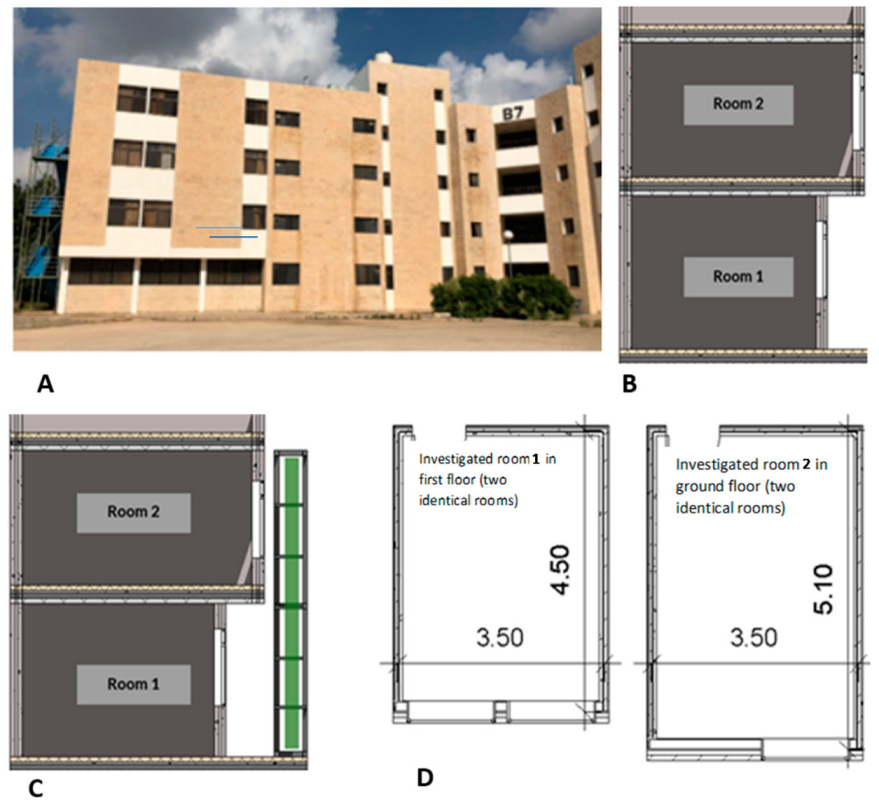


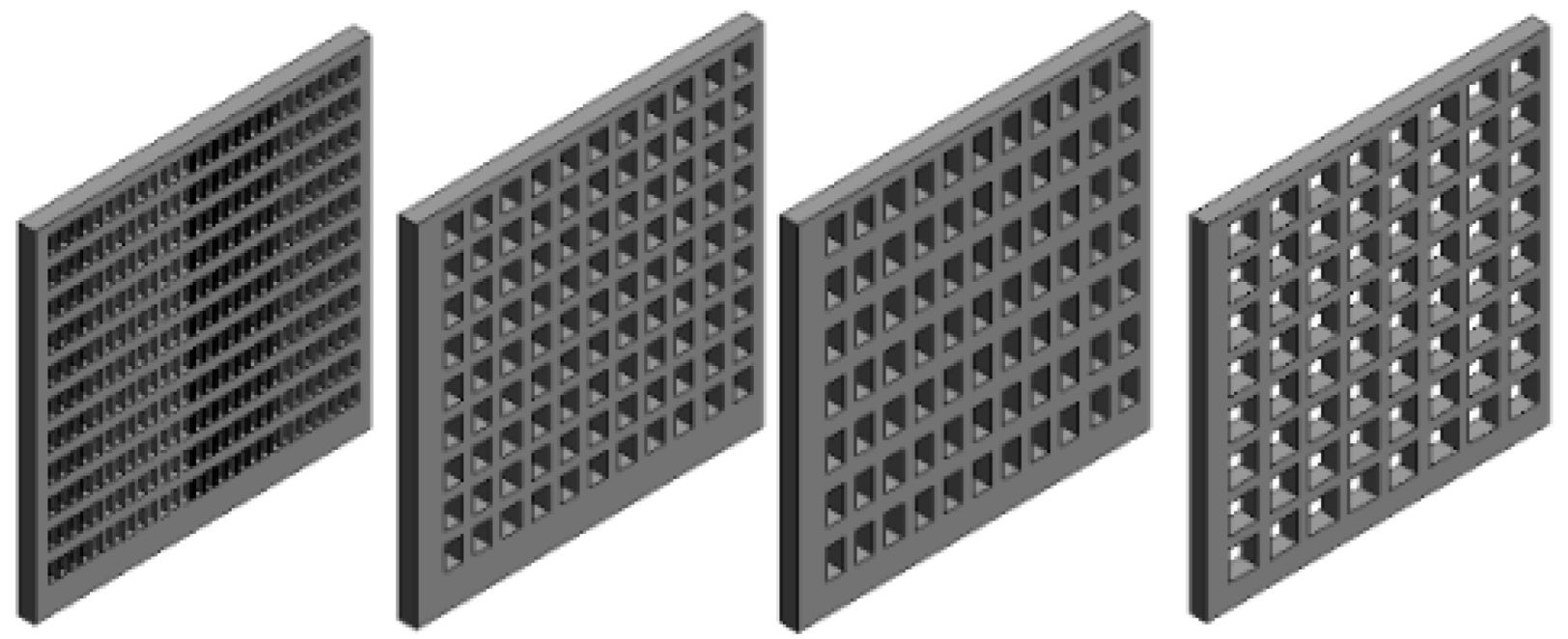




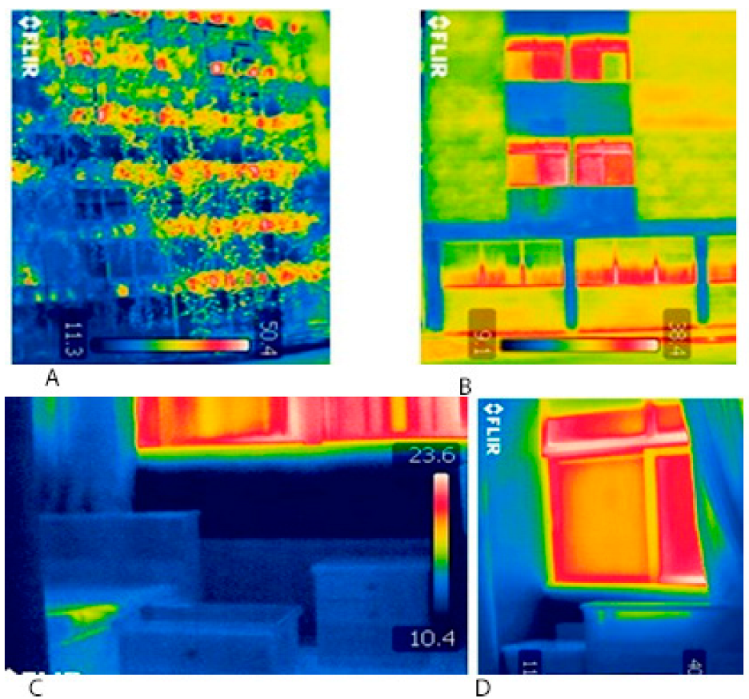
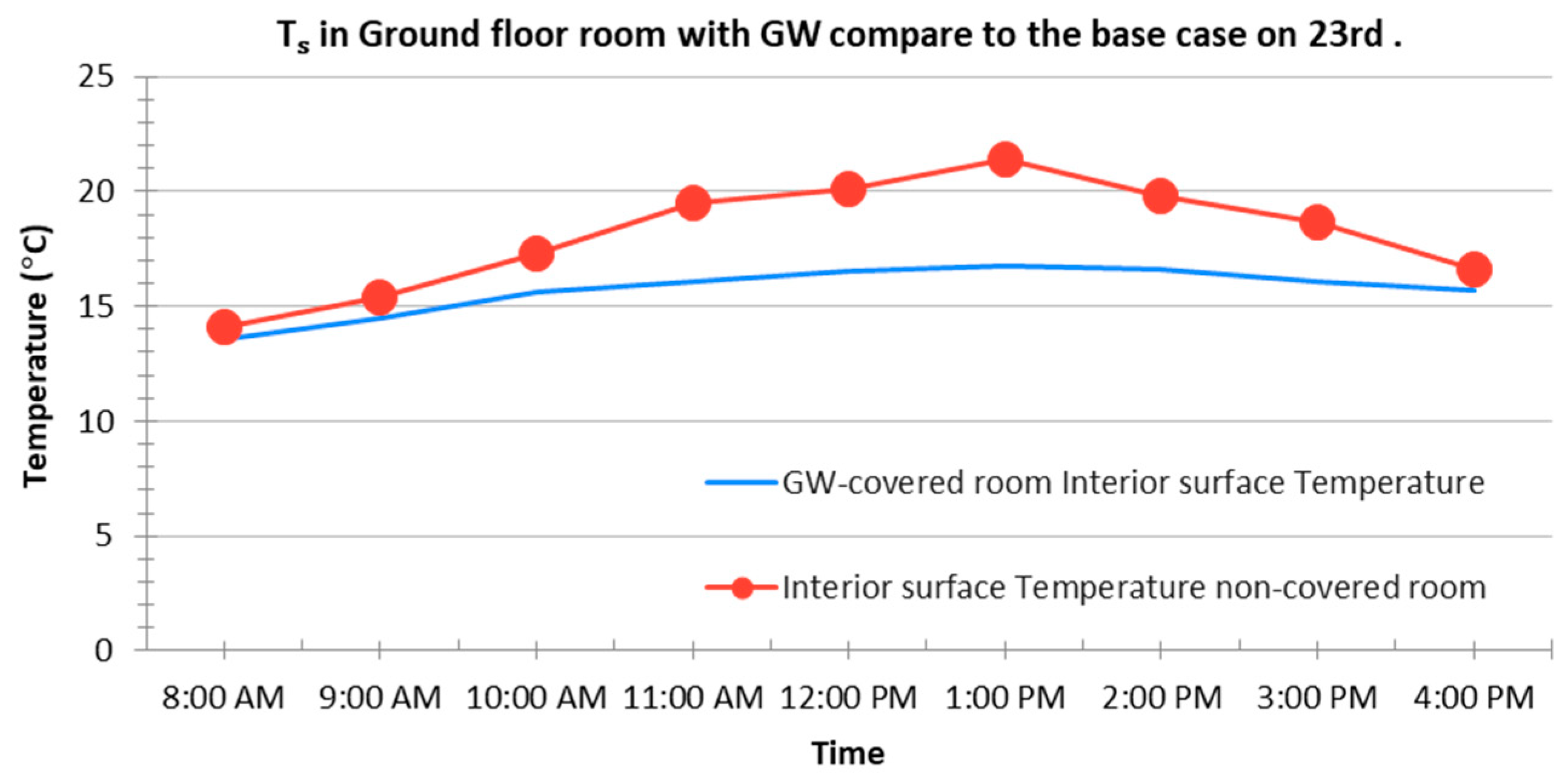


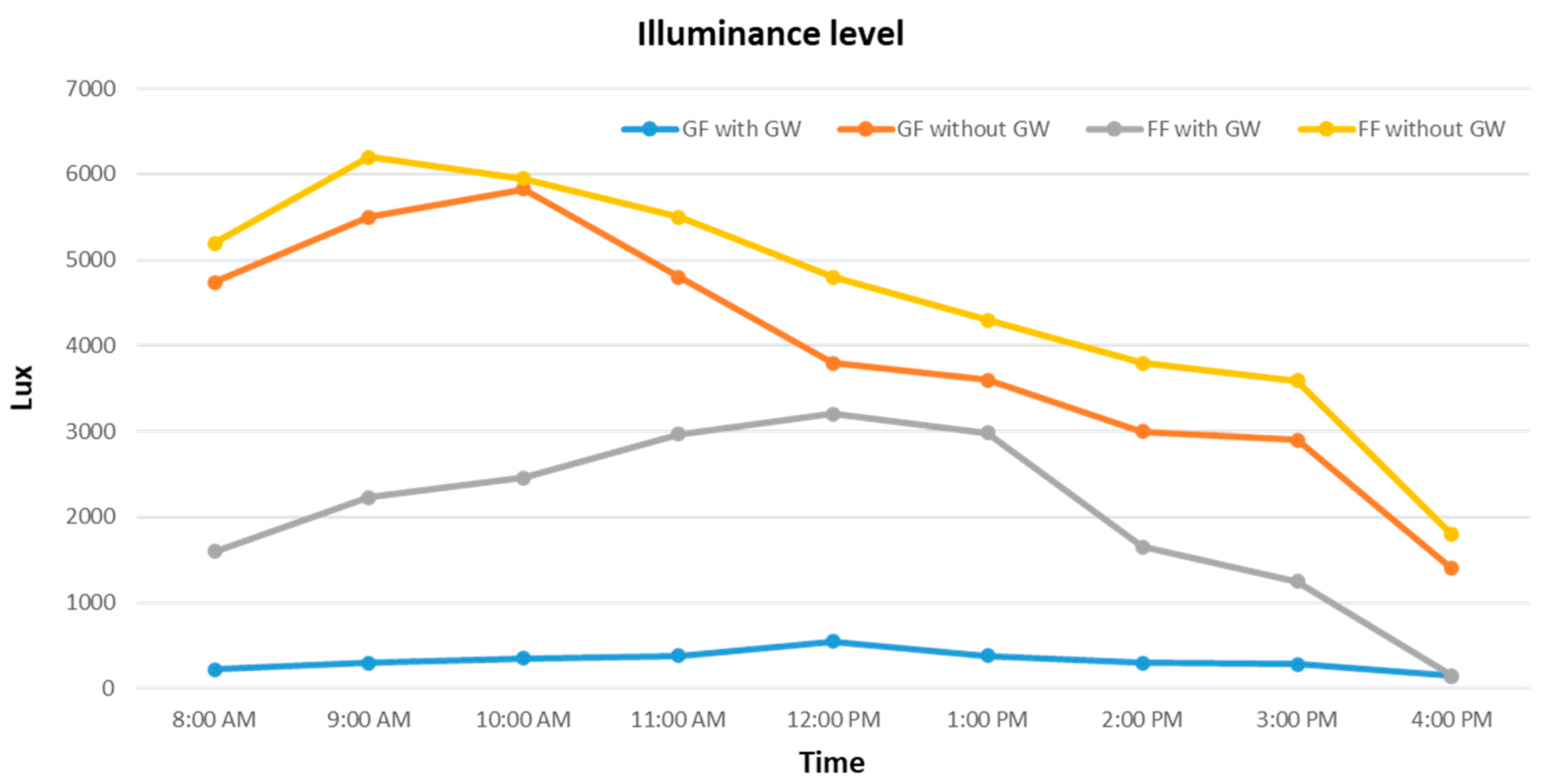
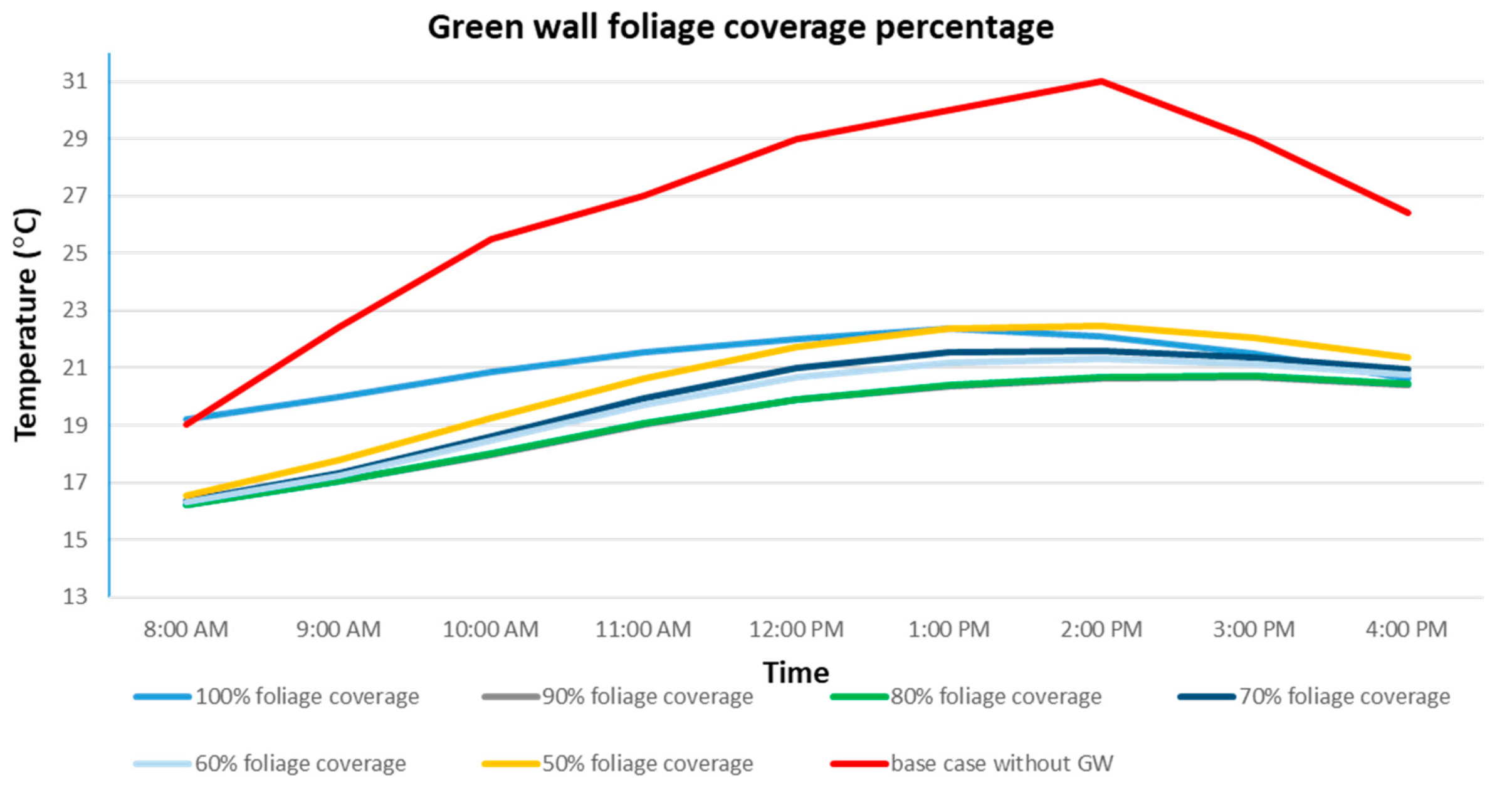

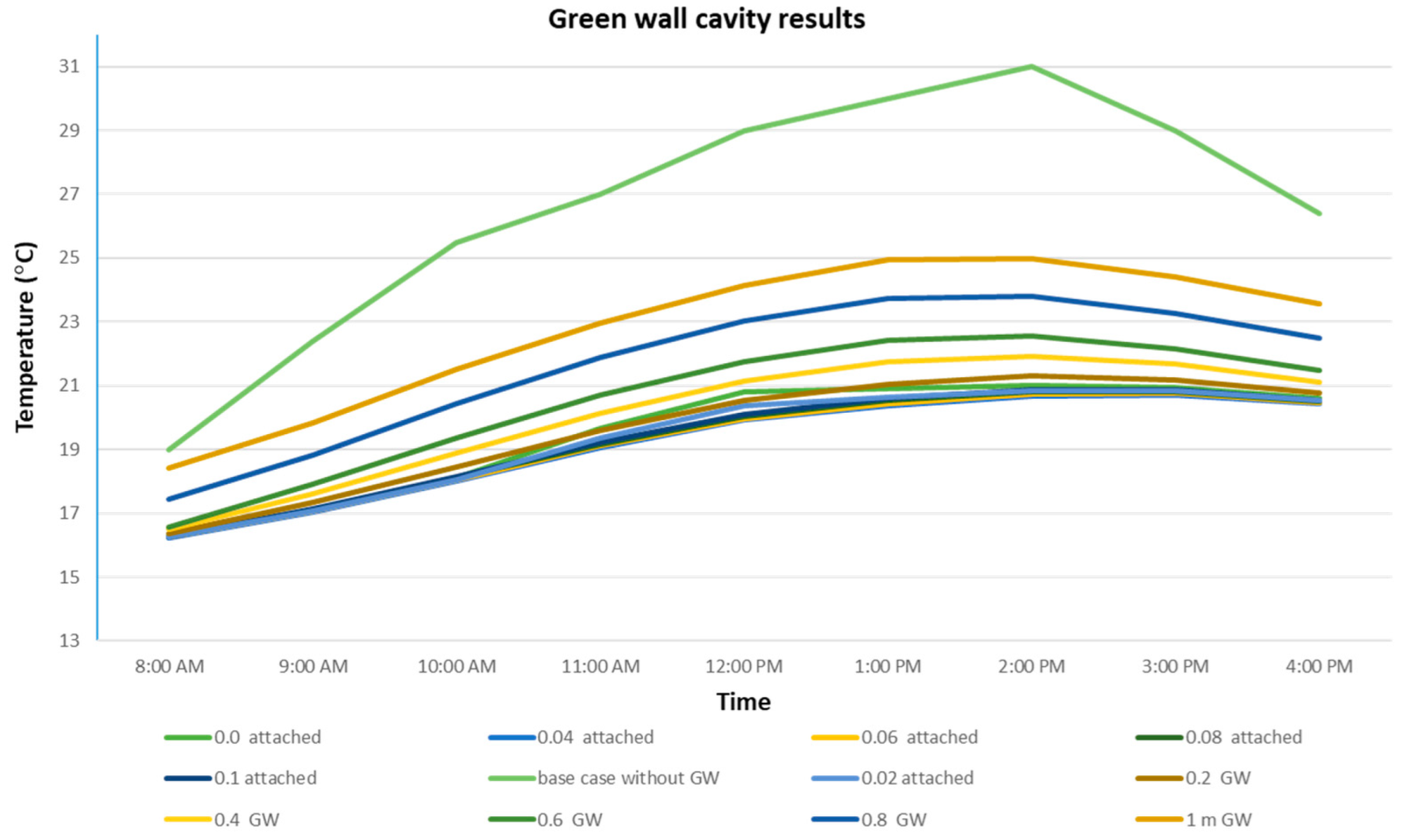
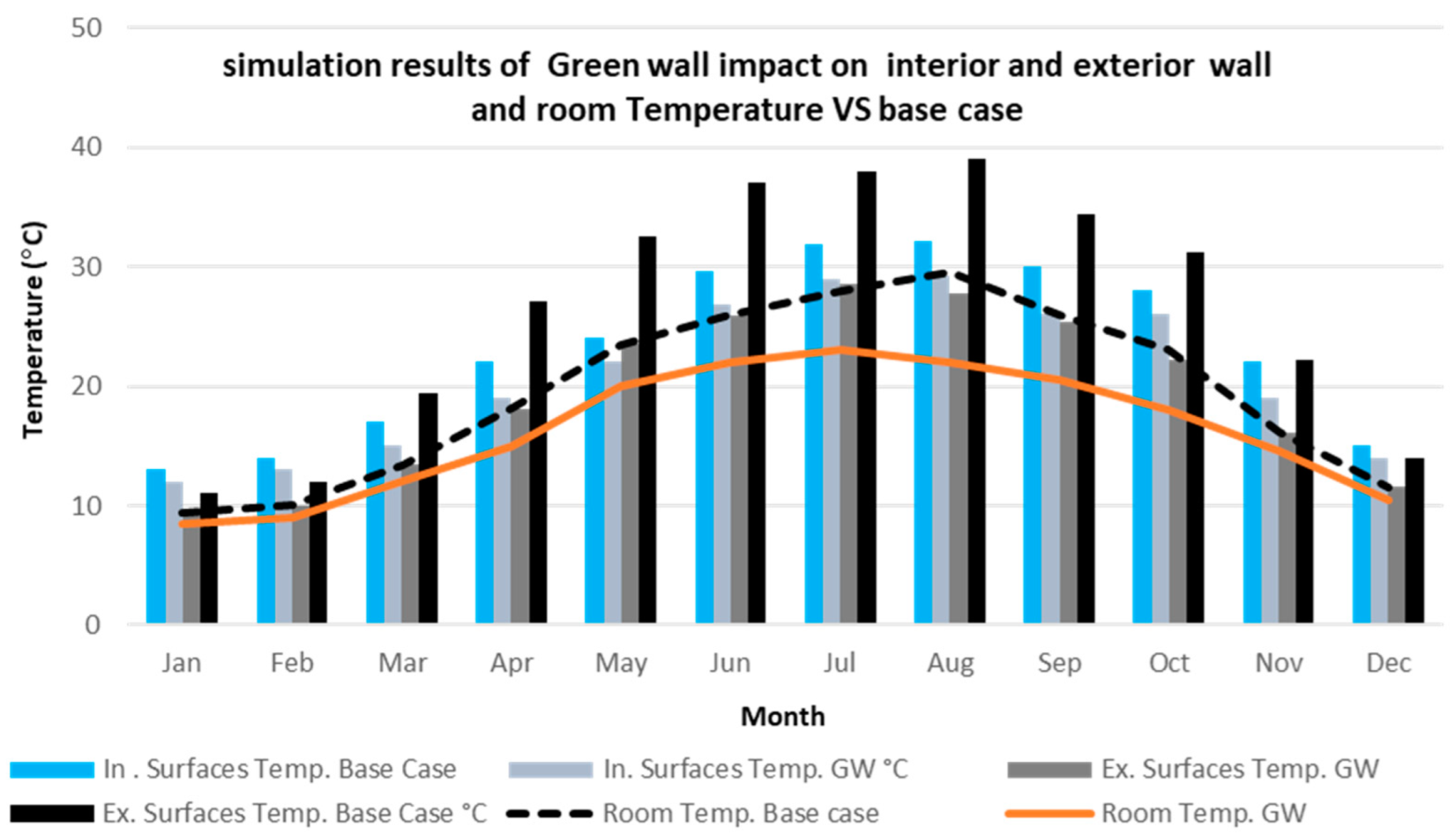
| U-Value (W/m2K) | Layers (from Inside to Outside) | Thickness | Component |
|---|---|---|---|
| 1.736 | Cement plaster, precast concrete, cement plaster | 0.3 m | Exterior wall |
| 1.69 | Cement plaster, brick, cement plaster | 0.1 m | Interior wall |
| 1.4 | Gravel-based Soil, sand, Cast Reinforced concrete, cement plaster. | 0.38 m | Floor slab |
| 1.79 | H. helix, soil | 0.07 m | Green foliage layer |
| Model | Parameter | Measurement Frequency | Sensor Location |
|---|---|---|---|
| Temperature/RH data logging meter: Extech RHT20 | Ta, RH | 1 h | Indoor |
| IR temperature/wind velocity data logging meter: Extech HD300 | Ts, WV | 1 h | Surface of walls Indoor |
| Illuminance data logging: Extech HD400 (the light meter) | Ev | 1 h | Indoor (with 1 m height from GF level) |
| FLIR infrared camera FLIR B200 | Ta | 1 h | Outdoor |
| Scenario | Plant Coverage Percentage | Air Cavity Depth | Green Wall Porosity |
|---|---|---|---|
| Building 1 | 82% (air gap 18%) | Ground floor = 0.8 m First floor = 0.2 | 0.3 × 0.15 |
| Building 2 | 72% (air gap 28%) | GF = 0.8 m FF = 0.2 m | 0.5 × 0.3 |
| Building 3 | 55% (air gap 45%) | GF = 0.8 m FF = 0.2 m | 0.5 × 0.5 |
| Field Experiment | Approximately 62% (air gap 38%) | GF = 0.8 m FF = 0.2 m |
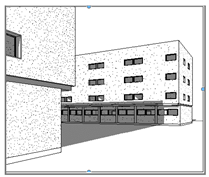 | 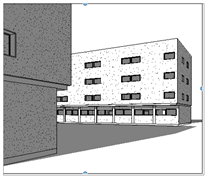 |  |  |
| 8:00 A.M. | 9:00 A.M. | 10:00 A.M. | 11:00 A.M. |
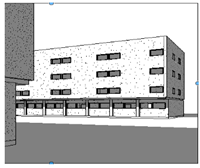 |  | 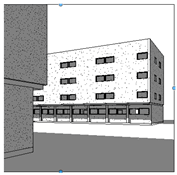 | 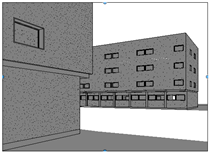 |
| 12:00 P.M. | 1:00 P.M. | 2:00 P.M. | 4:00 P.M. |
| Foliage | Cavity Air Depth (m) | |||||||||
|---|---|---|---|---|---|---|---|---|---|---|
| Coverage | Direct Green Wall | Double Skin Wall | ||||||||
| 0.02 | 0.04 | 0.06 | 0.08 | 0.1 | 0.2 | 0.4 | 0.6 | 0.8 | 1 | |
| 10% | (3) | (3) | (3) | (3) | (3) | (3) | (3) | (3) | (3) | (3) |
| 20% | (3) | (3) | (3) | (3) | (3) | (3) | (3) | (3) | (3) | (3) |
| 30% | (3) | (3) | (3) | (3) | (3) | (3) | (3) | (3) | (3) | (3) |
| 40% | (2) | (3) | (3) | (3) | (3) | (3) | (3) | (3) | (3) | (3) |
| 50% | (2) | (2) | (2) | (2) | (2) | (2) | (2) | (2) | (3) | (3) |
| 60% | (1) | (1) | (1) | (1) | (1) | (1) | (1) | (1) | (3) | (3) |
| 70% | (2) | (1) | (1) | (1) | (2) | (2) | (2) | (2) | (3) | (3) |
| 80% | (3) | (2) | (2) | (2) | (2) | (1) | (1) | (2) | (3) | (3) |
| 90% | (3) | (2) | (2) | (2) | (2) | (2) | (2) | (2) | (3) | (3) |
| 100% | (3) | (3) | (3) | (3) | (3) | (3) | (3) | (3) | (3) | (3) |
Publisher’s Note: MDPI stays neutral with regard to jurisdictional claims in published maps and institutional affiliations. |
© 2022 by the authors. Licensee MDPI, Basel, Switzerland. This article is an open access article distributed under the terms and conditions of the Creative Commons Attribution (CC BY) license (https://creativecommons.org/licenses/by/4.0/).
Share and Cite
Freewan, A.A.; Jaradat, N.M.; Amaireh, I.A. Optimizing Shading and Thermal Performances of Vertical Green Wall on Buildings in a Hot Arid Region. Buildings 2022, 12, 216. https://doi.org/10.3390/buildings12020216
Freewan AA, Jaradat NM, Amaireh IA. Optimizing Shading and Thermal Performances of Vertical Green Wall on Buildings in a Hot Arid Region. Buildings. 2022; 12(2):216. https://doi.org/10.3390/buildings12020216
Chicago/Turabian StyleFreewan, Ahmed A., Neda’a M. Jaradat, and Ikrima A. Amaireh. 2022. "Optimizing Shading and Thermal Performances of Vertical Green Wall on Buildings in a Hot Arid Region" Buildings 12, no. 2: 216. https://doi.org/10.3390/buildings12020216
APA StyleFreewan, A. A., Jaradat, N. M., & Amaireh, I. A. (2022). Optimizing Shading and Thermal Performances of Vertical Green Wall on Buildings in a Hot Arid Region. Buildings, 12(2), 216. https://doi.org/10.3390/buildings12020216






